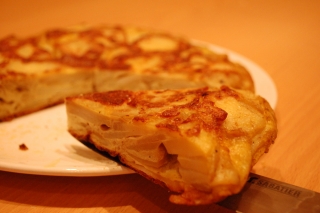I’m not going to insist you call it a tortilla. This is an international internet, and who knows I might have some American readers who would of course be entirely baffled by a tortilla made of egg, onion and potato.
When I first made a spanish omelette I was rather pleased with the result. It was as good as some of the pinchos of tortilla that I loved so much from our trip to Seville, which felt like a minor accomplishment. Since then I’ve ordered tortilla a few times at tapas bars in England and honestly they are usually rubbish. Too egg-y, too dry, or with random ingredients added in a truly dumb attempt to ruin what is a pure and elegant taste. Worst of all, sometimes it has been served hot. I should add that I’ve had some equally bad tortilla on other trips to Spain as well.
So it seems that I actually make a really good tortilla. Certainly everyone I’ve fed it to seem to agree, including one flattering (or maybe just polite) “I really don’t like things with egg in… but this is great”.
I find the tortilla immensely satisfying for a rather hard-to-explain reason. But I’ll try. Okay, it’s only made with three ingredients (four if you include olive oil). They’re also really cheap ingredients. And the result tastes better than the sum of its parts. This has been said before, but it isn’t the whole story: I could equally well be describing a bacon butty. No, the nifty bit is what you have at the end, once your tortilla has cooled. You can slice it! Wheel-like, as though it were a tart. Or even better, into little bite-sized cubes. There’s an inexplicably magical alchemy in taking a bunch of humble ingredients, doing nothing remotely high-falutin’ or chef-y with them, and yet ending up with tiny perfect cubes that have such an elegantly savoury taste.
I’ve written the recipe fairly long, just because there’s a few odds and ends to pay attention to which can make all the difference.
Spanish omelette, tortilla if you must
Supper for 4, with a salad
1 large onion
5 large eggs
olive oil
- Waxy potatoes are better than floury. Peel the potatoes and par-boil them for five minutes in salted water. If they’re big potatoes, halve them first. Let them cool a little, then slice thinly – thinner than a £1 coin if you can.
- Peel the onion, chop in half, then thinly slice each half. Pour about 6 tbsp olive oil into a non-stick 7 inch (20 cm) frying pan and fry the onions on a low heat. You don’t want to colour them at all.
- Once the onions are soft, add the potatoes and move them around to get them all coated in oil. Season with salt and plenty of pepper, stir again.
- Cover the pan and leave it on the lowest possible heat. Every 5-10 minutes lift the lid and turn the potatoes so that those on the bottom don’t burn and those on the top get to the bottom.
- How long it takes before they’re done varies a lot, but it could be 30 minutes. They’re done when the potato slices are fully cooked – prod a couple to make sure they fall in half.
- Beat the eggs in a large bowl and season, then dump the potatoes and onions in and mix together. Your pan may or may not need a quick wash, depending how good the non-stick is.
- Get the pan back on a high heat, with a fresh splash of olive oil. Once it is very hot, pour the mixture in and turn the heat down to the lowest setting again. Fiddle around a bit to get neat edges and a flat top.
- Now leave it on the low heat, uncovered, for perhaps 30 minutes. This will also vary. You want the bottom to be browned without burning, but of course you can only really check by lifting the edges a bit.
- Shake the pan to ensure the omelette is loose from the bottom. You may need to fiddle underneath with a spatula if it has got stuck. You now need to slide the entire thing out onto a plate at least as big as the pan.
- Now put the pan over the omelette on the plate, grab hold of plate and pan with oven gloves, and flip the whole thing upside-down. Please take a few moments to make sure you have a clear space to put it down, and have worked out a sensible grip so you don’t end up doing contortions.
- The pan goes back on the hob, with the other side of the omelette now cooking. This should only be another 5 minutes or so, 10 if you feel the centre was still very uncooked. You can actually slice the whole omelette in half in the pan to double-check the centre, if you need to.
- Slide the finished omelette back onto the plate. And now for the most important step of the recipe: let it cool right down to room temperature before you go anywhere near it.
Hot spanish omelette is edible, but really not good. Fridge-cold spanish omelette is also pretty poor. Room temperature is absolutely right. Always. A slice of spanish omelette makes a nice supper with some salad, and goes very well with chorizo or any manner of sausages. Great for picnics and snacks. It keeps for a couple of days, though not in this house.




4 pings